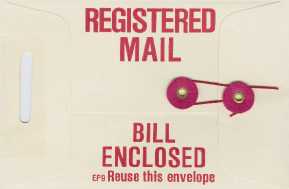| |
the bill properly completed, you are ready to place the
articles in the pouch. Pouching is accomplished by:
Tying the registered articles in bundles as listed
on PS Form 3854.
Placing the original inside manifold dispatch bill
under the top piece of the bundle. If there is more
than one bundle, place the separate manifold
dispatch bills under the top piece of each bundle.
Each bundle should remain in the sequential
order you used on the manifold bill. If articles
cannot be tied into a bundle, put the original bill
in an EP-9 (Registry Jacket Envelope) and place
it inside the pouch with the articles. See figure
7-9. Retain the duplicate inside bill in the MPO
files.
Closing and securing the pouch in the presence
of the witness using a numbered tin band seal
(USPS Item No. 817-C). See figure 7-10.
Method of Sealing
Place the numbered seal on the pouch (see figure
7-11) in the following manner:
Preparing the Slide Label
Pouches should be labeled (see figure 7-12) to the
off-load destination, unless sufficient volume of
registered mail is available to make up a direct pouch.
The first line of the label should indicate the
destination.
The second line should show the
endorsement REGISTERED and the weight listed in
kilograms. The third line should show the office of
origin, which is the MPO preparing the pouch for
dispatch. For ships, this is the ship’s name and hull
number; i.e., USS THE SULLIVANS (DDG-68). For
shore installations, this is the dispatching command’s
FPO number; i.e., FPO AP 96522. The slide label
should be dated on the reverse side with the APDS and
initialed by the registry clerk closing the pouch.
REGISTERED OUTSIDE PIECES
Normally, registered articles dispatched from a
military post office are enclosed in a pouch and secured
with a numbered seal, except when impossible because
of size or shape. If an article cannot be enclosed in a
pouch, treat it as an outside piece.
DISPATCHING MAIL DIRECTLY TO U.S.
COMMERCIAL AND MILITARY AIR
CARRIERS
You are now ready to affix the proper airport-coded
tags and/or labels to each individual registered pouch
or outside piece.
These tags and labels provide
information to the air carrier on the method for
handling and routing the pouch or outside piece from
the time of acceptance to arrival at the airport of final
destination. You must exercise caution in the selection
and preparation of these tags and labels to prevent
misrouting by the air carrier. PS Tag 135-E (see figure
7-13) should be affixed to each pouch, and PS Label
136-E (see figure 7-14) should be affixed to each
outside piece. When affixing PS Label 136-E, be sure
not to conceal any portion of the registry number. The
tags/labels should be serially numbered to identify the
total number of articles dispatched to the off-load
destination (for example: 1 of 6, 2 of 6, and so forth).
Specific guidelines for the use and completion of
airport-coded tags and labels for registered mail are
found in the USPS Handbook T-7 and should be
followed.
The dispatching activity should also record the
seal number of each pouch and the registered number
of each outside piece on PS Form 3854. This is called
an outside bill (see figure 7-15).
The outside bill
should be completed in triplicate, showing office of
origin, as well as office of destination. In addition, the
letter “O” should precede the registered number of
each outside piece. The letter “S” should precede the
number of each numbered seal pouch. When available,
the five-digit ZIP Code should be used instead of the
7-10
US MAIL 14387482
PCf0710
Figure 7-10.—An example of a numbered tin band seal used to
seal registered pouches.
PCf0709
Figure 7-9.—An example of an EP-9, Registry Jacket
Envelope.
|

